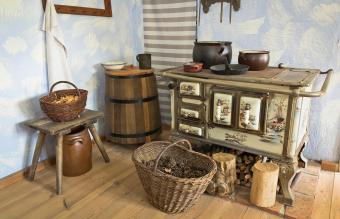
Nothing adds warmth to your home like an antique wood stove. Identification of these functional heating appliances is important if you want to know more about their history and value. From patent numbers to styles, there are several clues that help you identify your antique wood stove.
Antique Wood Stove Identification Tips
Finding an antique wood stove can be exciting, and most old stoves offer hints about their history. Use these tips to help.
Determine the Type of Wood Stove
The first step in antique wood stove identification is determining what type of stove you have. These are some of the common options:
- Franklin stoves - Designed by Benjamin Franklin in the 1700s, this type of antique wood stove is rarely used today for safety reasons. It's similar to a fireplace insert and often has hinged doors for adding wood.
- Cast iron wood-burning stoves - These are what many people think of when they consider wood stoves. They have a pipe extending from the back or top and a door for adding wood.

- Soapstone wood stoves - Constructed from soapstone instead of metal, these stoves were excellent at conducting heat.
- Ceramic wood stoves - Popular in the 1800s, these stoves often feature ceramic tiles that help conduct heat and keep a room warm after the fire has gone out.
- Pot-bellied stoves - This type of stove has a distinctive round shape, and the pipe usually extends up from the top. These are often made of cast iron.
- Eisenglass stoves - These stoves feature a viewing window to allow people to watch the fire. Eisenglass is made of compressed mica and tends to flake and discolor over time.
- Parlor stoves - These fancy Victorian stoves are beautiful to see and tend to be more diminutive than their larger counterparts. They were designed to heat one or two rooms.
- Wood cook stoves - These stoves usually had burners on the top, a stove box on one side for the fire, and an oven on the other side. Many are cast iron, which is often enameled.

Look for a Brand Name
From wood burning kitchen stoves to fancy parlor models, many old wood stoves include the manufacturer's name somewhere on the body of the stove. Look carefully at the metal of the stove door to see if a name is embossed there. If not, look at the sides and back of the stove, especially near the bottom edges. Finally, look for a metal plate affixed to the back of the stove that may bear the brand name. These are a few brand names you might see on your stove, but there are dozens:
- Charter Oak Stove Company
- Glenwood
- Queen Atlantic
- Walker and Pratt
- Barstow
- Acme

Check for a Patent Number
Many old wood stoves, especially those constructed from cast iron, will feature a patent somewhere on the stove. Look for a series of numbers, sometimes preceded by the letters "PAT." Note the patent number and look it up at the United States Patent Office. You can find information on any patent issued after 1790.
How Much Are Old Stoves Worth?
Old stoves can be worth a great deal of money, especially in uncertain times. It's common to see antique stoves selling for several hundred dollars. However, condition is a major factor. If your stove is cracked, seriously rusted, or has other significant damage, it will be worth considerably less. It's also important to note that local demand plays a role in value, since shipping a heavy woodstove is often cost prohibitive. To find the value of an antique wood stove, you can compare your stove against recently sold stoves like these:
- A Victor enamel cook stove sold on eBay for about $1,250.00.
- An ornate Victorian cast iron parlor stove in lovely condition sold for about $500.
- A small wood heating stove from the Civil War era in fair condition sold for about $300.
Have Antique Stoves Professionally Installed
If you decide to put your antique wood stove to use, be sure to have it professionally installed. Antique wood stove installation is not a simple DIY project, but once the installation is complete, you can use this functional antique for many years to come.







